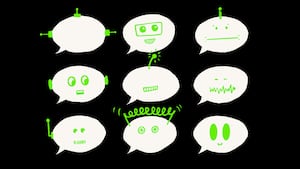Take a look around and it might seem like the robot overlords have won: Artificial intelligence is here, easily available, and hard to avoid. Even our kids have found their way to chatbots, AI essay writers, AI-enabled toys, and AI-generated art. A poll from Common Sense Media says 58 percent of teens have used or use chatbots and that 53 percent use ChatGPT instead of Google for searches. A rapidly growing number of them are beginning to rely on these bots for their homework assignments too.
Perhaps most disconcerting, though, are the kids who use AI chatbots to help them develop social skills—a process that’s also referred to as social and emotional learning (SEL). Typically, SEL is learned through methods you might expect, such as play and interactions with other children, developing relationships with parents and teachers, or through extracurricular activities like sports or even gaming.
However, with kids increasing their use of AI as a means of communication and socialization, many parents and educators are worried—and curious—about how these SEL skills are going to be influenced by the use of AI.
“When it comes to research on AI’s effects on children’s social and emotional learning, the body of research is still small, but it’s growing,” Tia Kim, vice president of education, research, and impact at education nonprofit Committee for Children, told The Daily Beast. “Neuroscience research finds that all learning is social and emotional, and it’s important to remember that these competencies are developed via human relationships, over time, and through practice.”
AI is already being used in classrooms and many teachers are finding creative and effective ways to incorporate it into class learning. Embracing such innovation as tools to education is necessary and could lead to positive learning outcomes, Kim explained. The technology can help save teachers time on tasks such as ideation for lesson plans or managing student data. However, Kim warns that it can never replace social and emotional skills learned from a parent or an educator.
However, when it comes to these skills outside of the classroom setting, the gray area increases. “Children need to learn social-emotional skills in human contexts for their positive development,” Kim said. That said, she said that AI has the potential to “teach children important social and emotional life skills” because of the ability of the technology to provide real-time feedback.
This can sound scary to adults unfamiliar with the technology—but Ash Brandin, a middle-school teacher who helps families navigate technology, told The Daily Beast that this was also the case in the early days of the internet, social media, or any other emerging technology. “We spent countless hours in internet chat rooms with a lack of physical social cues,” Brandin said.
AI tools like chatbots could be used to help kids with social anxiety acclimate themselves to social situations. Think of it like practicing what you’re going to say to a date or friend in front of the mirror—but for the digital age. In these scenarios, children use AI instead of a stranger on the internet or their own reflection. This wouldn’t mean replacing other types of interactions. Instead, it can improve them.
Using bots like ChatGPT or Bard in this way gives young people the chance to workshop an interaction, or to go through a rough draft with judgment-free feedback. In fact, the adaptive abilities of AI tools can even help kids navigate their real flesh-and-blood social lives. “Although they’re not getting organic human feedback, they are getting some feedback,” Brandin said.
Of course, it isn’t a panacea. Children still need to interact with other people to learn social and emotional skills. If children are talking to a chatbot or smart speaker but not friends, they’re not setting themselves up for emotional health in the long run, Brandin said. That’s why they recommend encouraging kids to try out these “drafts” on trusted humans like their parents. However, if they’re turning to bots for the social fulfillment they’d typically get from in-person interactions, then it “might be a time to step in and hold some boundaries.”
Even when using AI in conjunction with in-person interactions, without the foundational skills of knowing what a good social interaction looks like, the technology is pointless. It’d be akin to handing someone a hammer and telling them to build a house without any further instruction. The child ultimately determines whether or not an AI is misleading them, plagiarizing others, or being biased. Both Kim and Brandin emphasize the importance of parents and teachers collaborating with each other and the technology to make sure the baseline skills are in place.
Another reason why it’s important for parents and educators to have open dialogue with kids about their use of AI is because AI is trained with biases in their datasets which can result in harmful outputs. This can range from chatbots espousing racist, sexist, or otherwise problematic results, or even AI image generators creating harmful images. That’s why Kim encourages parents and teachers to do their research behind the AI they and their children use.
“Is the organization behind the AI being responsible?” she said. “Is the AI age-appropriate for kids and research-based? Does the company thoroughly and continuously test its products to mitigate bias and any potential harms?”
If AI programs are not transparent with their ethics or if they clearly show bias, it will create more harm than good. This is similar to how having a friend with unkind beliefs and attitudes influencing a kid will also shape their sense of self and behavior toward others.
AI has proven itself to be more than a fad—and it will continue to grow. Kim predicts that “as AI becomes even more advanced and integrated into our everyday lives, having social and emotional skills like the ability to read a room, show compassion, or motivate a team will become even more important as children grow up and eventually enter the workforce.”
“This is because people will still need to be able to be respectful, make responsible decisions, and understand one another’s perspectives even if we have AI-enabled tools to make our work easier,” she added.
Parents and caregivers need not fear the rise of AI, but they do need to embrace it and pair it with the work they’re already implementing in school and at home. Not that they have much of a choice. The technology is here to stay and will continue to grow—and our kids will grow with it.









